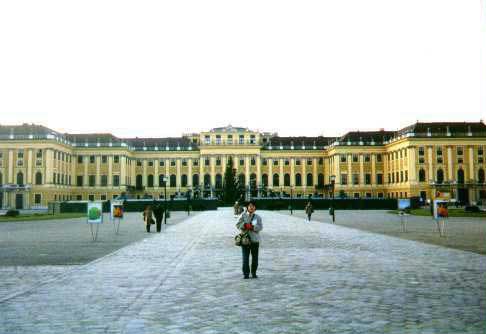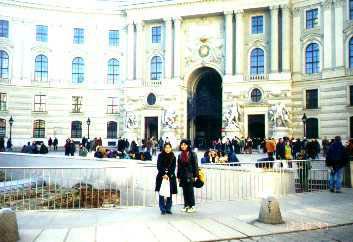St.
Stephan's Cathedral
The
Graben shopping street and two famous cake shops
The State Opera House
Hapsburg
Palaces
Additional sources:
Austria. C. Michelin
et Cie, Propriétaires — Éditeurs 1992
Encyclopedia Britannica Online
Fodor’s Austria. 1998. 8th Edition.
A Guide to Central Europe, by Richard Basset. 1987, Penguin Group, London
“On the trail of the Hapsburgs” by
John Fitzgerald, The Japan Times, July 28,1999
Schoenbrunn Web site
|
Wall-to-wall history in Vienna’s Palaces
by Tim Young
From SIF Satellite #54, Summer 1999
 |
| Schoenbrunn |
Perhaps the six-year-old boy, a musical prodigy, was nervous
about visiting the palace. That may be why he slipped and fell in the
corridor. Or maybe he was just running in the halls, being reckless on
purpose—that would seem more in keeping with his character. At any rate, the archduchess, herself only seven years old, walked over to help him up. The boy, touched, looked up at her and declared, “I’ll marry you when I’m grown up!”
The boy’s name was Wolfgang Amadeus Mozart; the archduchess, Marie-Antoinette, daughter of Maria Theresa, empress of Austria.
This is just one of many stories of the Hapsburgs
(also spelled Habsburg), who ruled much of Europe for many generations.
Since 1282, their power was centered in Austria; their dynastic rule only
came to an end in 1918, in the aftermath of World War I. They reached
the peak of their power in the 16th century, when they controlled much
of central and southern Europe, surrounding France on all sides except
along its coast. If the walls of their palaces could talk to us, they
would make history come alive.
In Austria, the memory of the Hapsburgs is still
revered, particularly of Emperor Franz Josef (1848-1916) and his consort,
Elisabeth, whom he married in 1854. Elisabeth has been compared to Britain’s Princess Diana; she was obsessed with keeping her figure, chafed under the rigors of royal life, and by the 1870s was spending much of her time traveling, seeing her husband less and less; Franz Joseph, however, is said to have remained deeply in love with her. Images of both can be seen all over Vienna, including large cutouts of them standing in front of the cake shop Damal (see Satellite 52).
Elisabeth, known affectionately as Sisi, is the focus
of several fan clubs in Austria to this day; a hugely successful musical
is based on her life, and movies have been made about her as well. Also
like Diana, Sisi met a tragic end: she was stabbed and killed by an Italian
anarchist in 1898.
Naturally, the Hapsburgs are a big part of Vienna’s attraction to tourists as well. Their palaces — the huge, luxurious Schoenbrunn and the expansive Hofburg complex, home to the New Palace — are visited by thousands each year. Two who visited them, in late 1997, were Ozaki Mioko and Kaneko Akiko.
City within a city
 |
| Mioko and Akiko at Hofburg |
The Hofburg lies in the heart of Vienna, and has been called “a city within a city.” Begun in 1220, it was gradually expanded over the centuries, growing into a complex of palaces, gardens, chapels, and the famous Spanish Riding School. Between 1881 and 1908, the New Palace was constructed here, only to lose its status as a royal residence ten years after its completion. Parts of the complex are now government offices.
Mioko says the New Palace is like a museum. “You can enter the National Library, or you can see the places where kings lived, and also there was a treasure museum, and I entered the kings’ and queens’ rooms.” The photo below shows Mioko and Akiko in front of the domed entrance to the Hofburg, facing St. Michael’s Cathedral. Richard Basset writes that the entrance “is a hybrid creation dating from two different periods. The conception is unashamedly Baroque, but the craftsmanship is unmistakably nineteenth-century...”
The Hofburg complex includes two Imperial treasuries, six museums, and the Imperial apartments. These are found to the left of the main entrance. Basset recommends a tour of the twenty rooms open to the public, which “offer an insight into life at the Austrian court which can only be glimpsed in other parts of the building.” He calls attention to the dining room, where guests were often served multi-course meals and yet went hungry—particularly in the time of Franz Joseph. The Emperor, who was served first, was a notoriously quick eater. When he finished, all the dishes were cleared away, so you definitely didn’t want to be the person who was served last! Elisabeth’s presence at these meals made little difference, since she was often starving herself to stay thin.
A move to the country: Schoenbrunn
In 1569, during the reign of Maximilian, an estate on the outskirts of Vienna came under Imperial ownership. A hunting lodge was built there in the 17th century, and a zoological garden that already existed there was expanded. A new hunting lodge, designed by Johann Bernhard Fischer von Erlach in 1696, was completed in 1711, with adjustments to its design. This was the Schoenbrunn Palace that stands to this day. Empress Maria Theresa made it her primary residence in the mid-18th century; subsequent rulers seem to have thought of it as their summer palace. The zoo is thought to have been the first in Europe; with the zoo grounds included, the entire complex covers more than 2 square kilometers.
Maria Theresa is remembered as being a very forceful woman. When her father, Emperor Charles VI, died in 1740, she was left as his heir, and was immediately challenged by a host of European powers, including France and Bavaria, in the War of the Austrian Succession. Her armies managed to keep control of most of the lands she had inherited from Charles. She then managed to get her husband, Francis Stephen (Francis I) elected as Holy Roman Emperor, but in fact she herself called the shots in the government. She engineered the marriage of Marie-Antoinette to Louis XVI as a way of sealing a peace pact with France.
Mioko says that much of Schoenbrunn—including the entire outside—was painted yellow because it was Maria Theresa’s favorite color. The Empress, who had 16 children (10 of whom survived to adulthood), also kept a collection of Chinese artifacts, which are still on display there in one room—porcelain dishes, clothes, etc. China was the theme of that particular room: “Each room had a theme, decorated in a different way. I think I saw about 40 rooms at Schoenbrunn.” Because of the wide variety in its decor, and also because of its greater size, Mioko thought Schoenberg “is better than the New Palace.”
Chinese and Japanese art had a strong influence on the decoration and furnishing of European palaces in the 18th century; Schoenbrunn also includes Chinese Cabinets (small rooms where conferences were held) and a “Blue Chinese Salon”, complete with rice-paper Chinese wall hangings. Other rooms feature gilded paintings showing scenes of Indian and Mogul life. “By looking at those rooms, you can see the Hapsburgs had great power at that time,” says Mioko.
Mioko was surprised at how many portraits there were in both palaces. “I think if you live in a room with a portrait, and if it’s vivid like a living person, it’s like you are watched always!
“But maybe it’s a city of many arts, sculptures and paintings,” she continues, “that maybe we can’t copy anymore, because it’s too detailed, and maybe kings who have those powers to make those detailed arts will not exist. Kings and queens who have power and status enough to enjoy those gorgeous houses.
“In Japan the arts are quite simple, detailed but very simple and quiet, and not gorgeous with gold and many colors.” Certainly European palaces like Schoenbrunn and Hofburg stand in stark contrast to the halls of power in Japan, where the decor is much more subdued. But no matter how the walls are decorated in a historic palace or castle, we wish those walls could talk.
|




 This page last updated
February 3, 2003
. E-mail Tim
This page last updated
February 3, 2003
. E-mail Tim